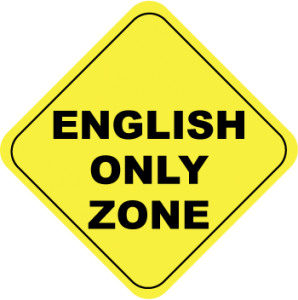The Whole Food’s incident, in which two employees accused the company of encouraging an English-only policy in the working environment and suspending them for speaking Spanish during the working hours, seems to have opened Pandora’s box in relation to a long-standing and unresolved issue that reaches deep into the American society: the use of English language as a means to exercise some kind of control over Latin American immigration.

The Early Origins of the English-Only Movement
Even though it may seem that the advocates of the English-Only Movement can only be found in recent years, especially as President Barack Obama is pushing an immigration reform, the truth is that its origins can be traced back to the 1800’s. In fact, during 1878 and 1879 the constitution of California was rewritten so that the Spanish language rights were no longer recognized and the English-only schooling was recommended to Native Americans. According to the official text “All laws of the State of California and all official writings, and the executive, legislative and judicial proceedings shall be conducted, preserved and published in no other than the English language”. Years later, English-only instruction laws were also passed in Wisconsin, Illinois and Hawaii.
The need of relying on the English language to provide some kind of unity and common bond to the American nation, which was being born at the time, is probably the main reason behind passing these laws.
Does the USA Need English as an Official Language?
Almost since its inception, the United States of America has been a pluralistic nation. Stating that it is a land of opportunities, it embraces warmly any immigrant that wants to fulfill the American Dream and help the country grow and prosper.
This multiculturalism has lead people from all over the world to come to the USA and, in many occasions, they do not know nor understand English and find it easier to communicate with peers in their mother tongue so that they do not feel pressed by the need of learning English.
As a result, many people doubt whether these immigrants are really integrated into society and question whether establishing English as the official language would be helpful in order to press them to learn English and therefore become fully functional American citizens.
There are different groups such as ProEnglish and U.S. English –just to mention the most important ones- that believe that in a pluralistic nation, it is important to foster and support the similarities and encourages public opinion and law makers to adopt English as the official language at all levels of the government as they consider English as the most empowering tool that immigrants have to succeed.
So far, the United States Federal Government does not specify an official language. However, all official documents in the U.S. are written in English, though some are also published in other languages. Looking at this issue state by state, a vast majority of them (33 out of 50) have passed laws that establish English as the official language in the state while some of them also accept the use of other language. Amongst these states we can mention: Hawaii, Wyoming, Idaho, Florida, Georgia, Indiana, Kansas and Kentucky.
Whether the United States need an official language or not, is a question that has caused quite an interesting controversy. While the ones that are pro this idea consider the English-only movement a good way of unifying a multicultural and multinational nation, there are many others that are convinced it is discriminatory and that it certainly contradicts the First Amendment and the right to freedom of speech.
These groups suggest that the union of people of the United States will be the result not of a single language being spoken but of exercising tolerance and pushing political measures that benefit all people equally no matter what their ethnic origin is. They deny that English is under threat and they claim that, many a time, these English-Only movements show hatred against non-English speaking immigrants.












